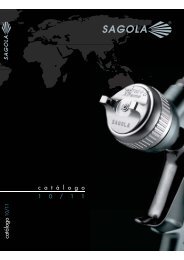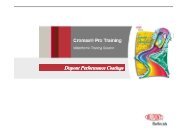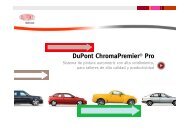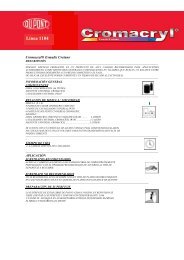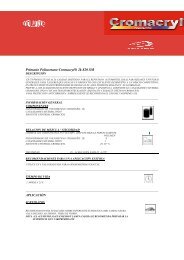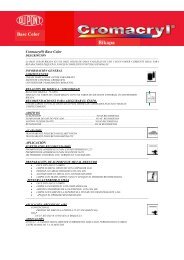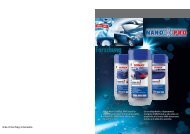MSDS 26 Cromax R Pro DuPont Performance Coatings Material ...
MSDS 26 Cromax R Pro DuPont Performance Coatings Material ...
MSDS 26 Cromax R Pro DuPont Performance Coatings Material ...
You also want an ePaper? Increase the reach of your titles
YUMPU automatically turns print PDFs into web optimized ePapers that Google loves.
<strong>MSDS</strong> <strong>26</strong><br />
<strong>Cromax</strong> R○ <strong>Pro</strong><br />
<strong>DuPont</strong> <strong>Performance</strong> <strong>Coatings</strong><br />
<strong>Material</strong> Safety Data Sheet<br />
January 1, 2010<br />
Page: 4<br />
Titanium dioxide (rutile)<br />
Is an IARC, NTP or OSHA carcinogen. In a lifetime inhalation test, lung cancers were found in some rats exposed to 250 mg/m3 respirable titanium dust. Analysis of the<br />
titanium dioxide concentrations in the rat’s lungs showed that the lung clearance mechanism was overwhelmed and that the results at the massive 250 mg/m3 level are<br />
not relevant to the workplace.‘Results of a <strong>DuPont</strong> epidemiology study showed that employees who had been exposed to Titanium Dioxide were at no greater risk of<br />
developing lung cancer than were employees who had not been exposed to Titanium dioxide. No pulmonary fibrosis was found in any of the employees and no<br />
association was observed between Titanium dioxide exposure and chronic respiratory disease or x-ray abnormalities. Based on the results of this study <strong>DuPont</strong><br />
concludes that titanium dioxide will not cause lung cancer or chronic respiratory disease in humans at concentrations experienced in the workplace.‘<br />
Urea-formaldehyde condensation polymer<br />
This chemical is a formaldehyde donor. Formaldehyde is an IARC, NTP or OSHA carcinogen and has shown mutagenic activity in laboratory cell culture tests. May<br />
induce pulmonary sensitization or significant irritation of the respiratory airways. Formaldehyde has produced tumors in the nasal passages of laboratory animals when<br />
exposed to high concentrations for a two year period. IARC has concluded epidemiology studies found evidence of formaldehyde related nasopharyngeal cancer in<br />
humans and have classified formaldehyde as a confirmed human carcinogen. <strong>DuPont</strong> toxicologists have reviewed these studies and classified formaldehyde as a<br />
possible human carcinogen.<br />
4. First aid measures<br />
First Aid <strong>Pro</strong>cedures:<br />
Inhalation:<br />
If affected by inhalation of vapor or spray mist, move to fresh air. If not breathing, give artificial respiration, preferably mouth-to-mouth. If breathing difficulty persists, or<br />
occurs later, consult a physician.<br />
Ingestion:<br />
In the unlikely event of ingestion, DO NOT INDUCE VOMITING. Call a physician immediately and have names of ingredients available.<br />
Skin or eye contact:<br />
In case of eye contact, immediately flush with plenty of water for at least 15 minutes; call a physician. In case of skin contact, wash thoroughly with soap and water. If<br />
irritation occurs, contact a physician.<br />
5. Fire-fighting measures<br />
Flash Point (Closed Cup):<br />
See Section 11 for exact values.<br />
Flammable Limits: LFL 1.2 % UFL 13.7 %<br />
Extinguishing Media:<br />
Universal aqueous film-forming foam, carbon dioxide, dry chemical.<br />
Fire Fighting <strong>Pro</strong>cedures:<br />
Full protective equipment, including self-contained breathing apparatus, is recommended. Water from fog nozzles may be used to prevent pressure build-up.<br />
Fire and Explosion Hazards:<br />
For flammable liquids, vapor/air will ignite when an ignition source is present. In other cases, when heated above the flash point, emits flammable vapors which, when<br />
mixed with air, can burn or be explosive. Fine mists or sprays may be flammable at temperatures below the flash point.<br />
6. Accidental release measures<br />
<strong>Pro</strong>cedures for cleaning up spills or leaks:<br />
Ventilate area. Remove sources of ignition. Prevent skin and eye contact and breathing of vapor. If material does not contain or is not mixed with an isocyanate<br />
activator/hardener: Wear a properly fitted air-purifying respirator with organic vapor cartridges (NIOSH approved TC-23C), eye protection, gloves and protective clothing.<br />
Confine, remove with inert absorbent, and dispose of properly. If the material contains, or is mixed with an isocyanate activator/hardener: Wear a positive-pressure,<br />
supplied-air respirator (NIOSH approved TC-19C), eye protection, gloves and protective clothing. Pour liquid decontamination solution over the spill and allow to sit at<br />
least 10 minutes. Typical decontamination solutions for isocyanate containing materials are: 20% Surfactant (Tergitol TMN 10) and 80% Water OR 0-10% Ammonia,<br />
2-5% Detergent and Water (balance). Pressure can be generated. Do not seal waste containers for 48 hours to allow C02 to vent. After 48 hours, material may be sealed<br />
and disposed of properly.<br />
Ecological information:<br />
There is no data available on the product. The product should not be allowed to enter drains, water courses or the soil.<br />
7. Handling and storage<br />
Precautions to be taken in handling and storing:<br />
Observe label precautions. If combustible (flashpoint between 38-93 deg C or 100 - 200 deg F), keep away from heat, sparks and flame. If flammable (flashpoint less<br />
than 38 deg C or 100 deg F), also keep away from static discharges and other sources of ignition. If material is extremely flammable (flashpoint less than - 8 deg C or 20<br />
deg F) or flammable, VAPORS MAY IGNITE EXPLOSIVELY OR CAUSE FLASH FIRE, respectively. Vapors may spread long distances. Prevent buildup of vapors. Close<br />
container after each use. Ground containers when pouring. Wash thoroughly after handling and before eating or smoking. Do not store above 49 deg C or 120 deg F. If<br />
product is waterbased, do not freeze.<br />
Other precautions:<br />
If material is a coating: do not sand, flame cut, braze or weld dry coating without a NIOSH approved air purifying respirator with particulate filters or appropriate<br />
ventilation, and gloves. Combustible dust clouds may be created where operations produce fine material (dust). Avoid formation of significant deposits of material as they<br />
may become airborne and form combustible dust clouds. Handling and processing operations should be conducted in accordance with best practices (e.g.NFPA-654).<br />
8. Exposure controls/personal protection<br />
Ventilation:<br />
<strong>Pro</strong>vide sufficient ventilation in volume and pattern to keep contaminants below applicable exposure limits.



